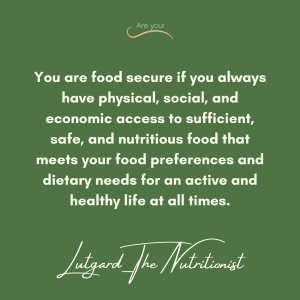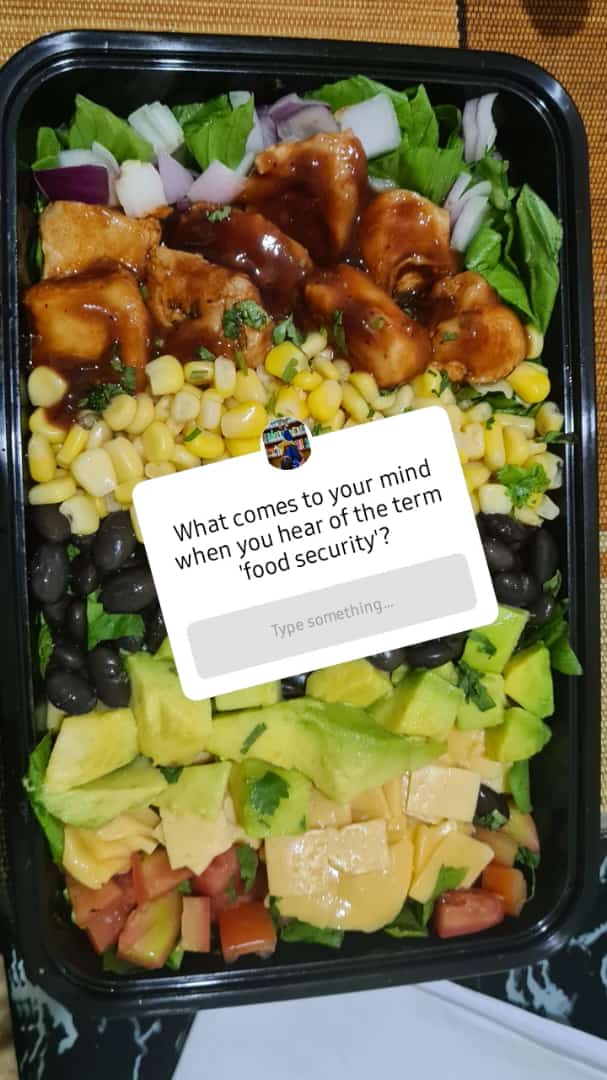When you hear the term food security, what comes to your mind? (You can share your answer in the comment section) but thanks to social media I made a question tag and asked friends of mine from all walks of life and I got very interesting answers. Here are some of them.
“I think it is the state of having enough food production for a given society preventing it from hunger and starvation” | “Civilizations as we know them” | “Enough/plenty of healthy food to last a particular season or time frame” | “Having more than enough foods” | “Abundance of food” | “Being assured of a meal every meal time” that’s what comes to mind when I see “food security” | “During my time with some NGO they regarded food security as food being 4 things; Available, Accessible, Adequate n Sustainable” | “Preserve the environment for constant food supply” | “Him; the ability of him to consistently eat at least one nutritious meal a day without compromising the ability of the future generations to do the same.” | “It’s food which should be guarded by security because some people overeat it” | “Food security: the ability for every human to have something to eat” | “Constant availability of food” | “When you are certain that you can always have food when you need it.” | “I think of the availability of food all through the year. Covers post-harvest handling for sustenance.” – I cannot exhaust all the responses I received.

According to Food and Agriculture Organisation (FAO), food security exists when all people, at all times, have physical and economic access to sufficient, safe, and nutritious food that meets their dietary needs and food preferences for an active and healthy life. This definition has gone through a metamorphosis over the changing decades and it is imperative to understand where it all began.
The term first originated in the mid-1970s, when the World Food Conference (1974) defined food security in terms of food supply ensuring the availability and price stability of basic foodstuffs at the international and national level:
“Availability at all times of adequate world food supplies of basic foodstuffs to sustain a steady expansion of food consumption and to offset fluctuations in production and prices”
Come 1983, FAO analysis shifted the focus to food access, leading to a definition based on the balance between the demand and supply side of the food security equation:
“Ensuring that all people at all times have both physical and economic access to the basic food that they need”
We did not stop there, the definition was yet again revised to include the individual and household level, in addition to the regional and national level of aggregation, in food security analysis. However, in 1986, the highly influential World Bank Report on Poverty and Hunger focused on the temporal dynamics of food insecurity. The report introduced the distinction between chronic food insecurity, associated with problems of continuing or structural poverty and low incomes, and transitory food insecurity, which involved periods of intensified pressure caused by natural disasters, economic collapse, or conflict.

Where are we now?
We have currently stationed at the World Food Summit (1996) definition which reinforces the multidimensional nature of food security and includes food access, availability, food use, and stability. (The definition I give in the beginning). Times keep changing and so will this definition as a response to the need and focus at the time. COVID19 brought in a new dimension and we can only wait to see how this comes into play.
State of food security and nutrition in the world
According to the latest State of food security and nutrition in the world in 2021, the number of people in the world affected by hunger increased in 2020 under the shadow of the COVID-19 pandemic after remaining virtually unchanged from 2014 to 2019. In terms of population, it was estimated that between 720 and 811 million people in the world faced hunger in 2020. The report noted then that the world was at a critical juncture. The scary reality is that it is estimated that around 660 million people may still face hunger in 2030, in part due to the lasting effects of the COVID-19 pandemic on global food security, 30 million more people than in a scenario in which the pandemic had not occurred unless bold actions are taken at all levels according to FAO.
Beyond hunger, nearly one in three people did not have access to adequate food in 2020, healthy diets were out of reach for 3 billion people, and under the shadow of COVID19, weaknesses in our food systems were exposed, which threatened the food security and nutrition of millions of people around the world. In Africa, 281.6 million people on the continent, over one-fifth of the population, faced hunger in 2020, which is 46.3 million more than in 2019. In Uganda, we are seeing what is happening to the Karamoja region which remains a hotspot for food insecurity despite the many interventions that have been devised over the years, refugees living in settlements continue to struggle to meet their needs and invest in livelihoods due to above-average prices and among those who grow food in the other remaining areas, stocks from below-average harvests were depleted earlier than usual, and many are struggling to access seeds for the ongoing second season. If this picture does not paint the picture of food security, I do not know what will.
What are the causes of this appalling food insecurity crisis?
First, you and I need to understand where this monster comes from and if we can do anything about it. Simply put this is what feeds this monster which in turn bites us
- Lack of access to farming land
- Climate change
- Land grabbing
- Conflict, wars
- irrational trade rules
- Rapid population growth
- Natural calamities like floods, pandemics
- Biofuels
- Market dominance by corporate giants
- Food wastage
- Price hikes in international food markets
So allow me to talk about what we can do in our own capacities to avert the situation or at least make it better because I feel this is already too long. In the meantime, share with me your thoughts in the comment section. I will be happy to hear from you.
See you next Wednesday

Good read!
Looking forward to all next to posts
Thank you
Very informative.
It sometimes scares me when I glimpse into the future and I get to see where we headed.
But again I remember that it’s that small gift that counts each day. When I share my food with my neighbor, slowly we can make the world a better place.
Thank you Vivian. Well said
Your knowledge for food and nutrition is inspiring. Keep the good work up
Thank you